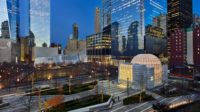Church at Worth Abbey












Architects & Firms
Crawley, U.K.
As if sparked by divine intervention, a design team led by Thomas Heatherwick completed and revitalized an important Modernist church by Francis Pollen (1926'87) for a historic Benedictine abbey, illuminating the late British architect's vision with craft and 21st-century technology.
Nestled in the bucolic West Sussex village of Crawley some 42 miles southeast of London, the Church of Our Lady, Help of Christians at Worth Abbey, built between 1964 and 1974, is one of the finest examples of that era's ecclesiastical architecture and listed as a Grade II* (or “particularly important”) building by England's Historic Buildings and Monuments Commission. It is also one of the region's largest churches, at approximately 17,000 square feet, seating up to 900 people in a vast volume that Pollen devised by incorporating bridge-building techniques into his scheme. But the striking sanctuary was never finished, and such essential details as permanent seating integral to the original circular plan were omitted. The lighting, too, was inadequate for the needs of the abbey's active community of 25 monks, the 550 students of the school they run, and the thriving congregation they serve.
Thanks to the recent contributions of generous benefactors, the design-savvy monks—including one former architect—were able to tap Heatherwick to renew and furnish the interior of their church in the round. The British designer and his studio restored the building's reinforced-concrete surfaces, replaced the windows, and improved the acoustics. They surrounded the central altar with exquisitely curved, fixed seating and choir stalls custom-made out of solid black walnut striped with ash. Then they created a distinctive portland-stone pulpit and holy-water stoups informed by Pollen's existing altar and baptismal font.
As improved lighting was crucial to the success of the project, Heatherwick engaged DPA Lighting Design to develop a strategy that would be invisible yet supply multiple layers of illumination. Most would have to be electric, because the only sunlight entering the room filters in through bands of clerestories encircling the perimeter walls and a 40-foot-wide lantern that pierces the conical timber-and-concrete roof above the altar. According to DPA's Gary Campbell, the light was very beautiful, but weak. The challenge, he explains, was to get an ample amount of well-controlled, nonglaring light down to the floor from the substantial height, which would improve light levels for reading. The monastery also requested a flexible, easy-to-use control system that would allow it to create appropriate settings for various services and events.
The first step was to refurbish Pollen's existing single-lamp fixtures—a series of cylindrical pendants and up/down sconces in rustic metal—retrofitting them with dimmable AR111 low-voltage halogen lamps. The DPA team rearranged the pendants over the clergy's seats to give them a focused beam, and supplemented the originals with four-lamp replicas suspended over the congregation to provide ambient, task, and emergency lighting (the last supplied by an auxiliary battery-powered LED). Then the team developed a robust 10-lamp version, motorized for maintenance, that hangs from the lantern's core and highlights the lectern and altar—also spotlighted for additional drama from the tops of four perimeter columns. Finally, the lighting designers tucked powerful LEDs on top of the lantern's crossbeams to brighten its walls indirectly, and rimmed its outer base with cold-cathode tubular lamping to wash the ceiling with an even glow. Everything is dimmable, and split up into zones and tasks.
The overall effect is theatrical, due in part to the preset scenes. “The architecture is stunning,” says Campbell. “And when you light that, it is incredible—like a stage set.”
People
Architect:
Lighting Designer:
Engineer:
Client:
Consultants:
General Contractor:
Size:
Completion Date: |
Products
Lighting Controls:
Lighting:
Electric Hoist: |










